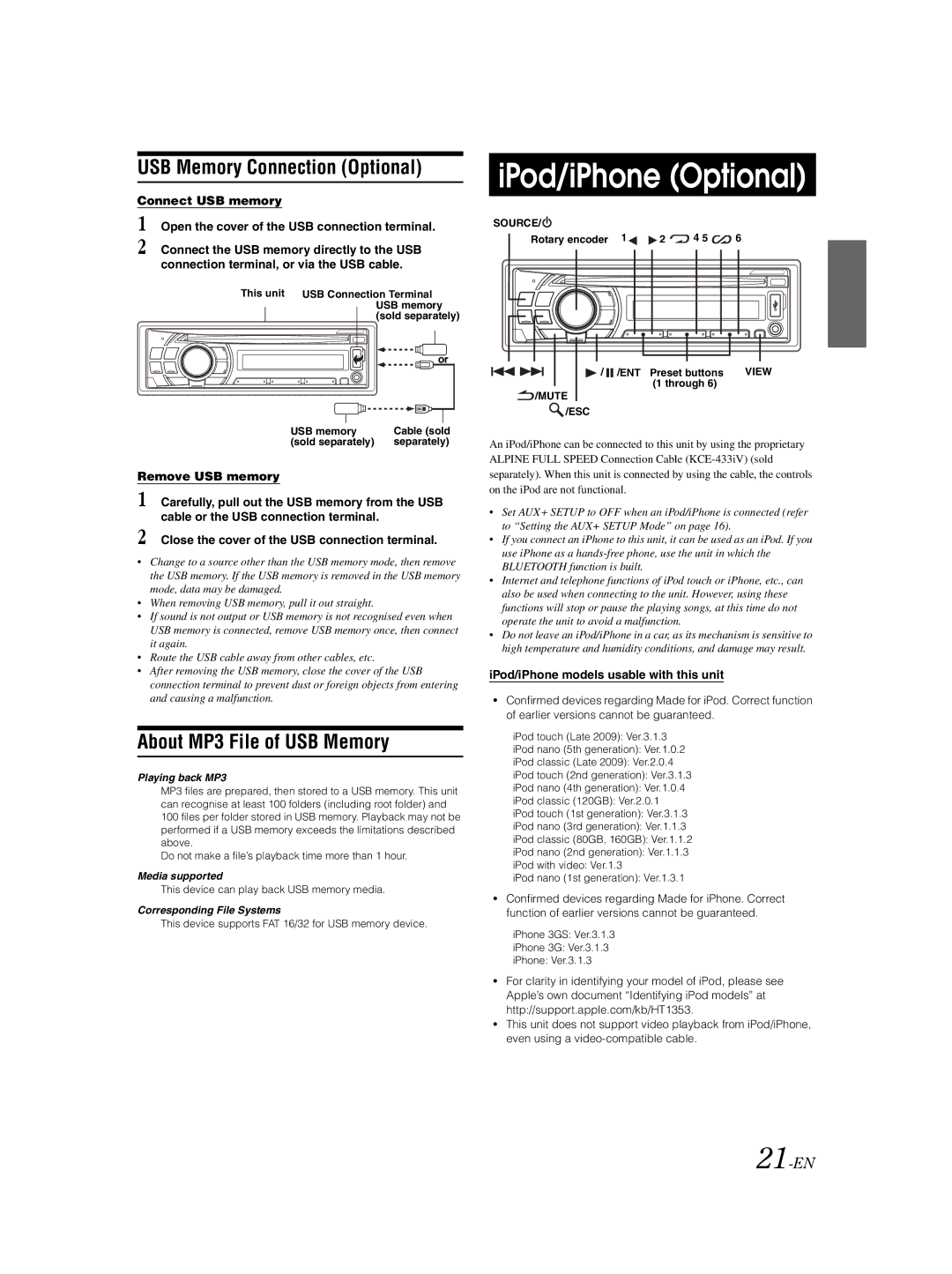
USB Memory Connection (Optional)
Connect USB memory
1 Open the cover of the USB connection terminal.
2 Connect the USB memory directly to the USB connection terminal, or via the USB cable.
This unit USB Connection Terminal USB memory (sold separately)
iPod/iPhone (Optional)
SOURCE/![]()
Rotary encoder 1 |
|
|
| 2 |
| 4 5 |
| 6 |
|
|
|
|
|
|
|
|
|
|
|
|
|
|
|
|
|
|
![]() or
or
USB memory | Cable (sold |
(sold separately) | separately) |
Remove USB memory
1 Carefully, pull out the USB memory from the USB cable or the USB connection terminal.
2 Close the cover of the USB connection terminal.
•Change to a source other than the USB memory mode, then remove the USB memory. If the USB memory is removed in the USB memory mode, data may be damaged.
•When removing USB memory, pull it out straight.
•If sound is not output or USB memory is not recognised even when USB memory is connected, remove USB memory once, then connect it again.
•Route the USB cable away from other cables, etc.
•After removing the USB memory, close the cover of the USB connection terminal to prevent dust or foreign objects from entering and causing a malfunction.
About MP3 File of USB Memory
Playing back MP3
MP3 files are prepared, then stored to a USB memory. This unit can recognise at least 100 folders (including root folder) and 100 files per folder stored in USB memory. Playback may not be performed if a USB memory exceeds the limitations described above.
Do not make a file’s playback time more than 1 hour.
Media supported
This device can play back USB memory media.
Corresponding File Systems
This device supports FAT 16/32 for USB memory device.
| / |
| /ENT Preset buttons | VIEW |
|
|
| (1 through 6) |
|
|
|
![]() /MUTE
/MUTE ![]() /ESC
/ESC
An iPod/iPhone can be connected to this unit by using the proprietary ALPINE FULL SPEED Connection Cable
•Set AUX+ SETUP to OFF when an iPod/iPhone is connected (refer to “Setting the AUX+ SETUP Mode” on page 16).
•If you connect an iPhone to this unit, it can be used as an iPod. If you use iPhone as a
•Internet and telephone functions of iPod touch or iPhone, etc., can also be used when connecting to the unit. However, using these functions will stop or pause the playing songs, at this time do not operate the unit to avoid a malfunction.
•Do not leave an iPod/iPhone in a car, as its mechanism is sensitive to high temperature and humidity conditions, and damage may result.
iPod/iPhone models usable with this unit
•Confirmed devices regarding Made for iPod. Correct function of earlier versions cannot be guaranteed.
iPod touch (Late 2009): Ver.3.1.3
iPod nano (5th generation): Ver.1.0.2
iPod classic (Late 2009): Ver.2.0.4
iPod touch (2nd generation): Ver.3.1.3
iPod nano (4th generation): Ver.1.0.4
iPod classic (120GB): Ver.2.0.1
iPod touch (1st generation): Ver.3.1.3
iPod nano (3rd generation): Ver.1.1.3
iPod classic (80GB, 160GB): Ver.1.1.2
iPod nano (2nd generation): Ver.1.1.3
iPod with video: Ver.1.3
iPod nano (1st generation): Ver.1.3.1
•Confirmed devices regarding Made for iPhone. Correct function of earlier versions cannot be guaranteed.
iPhone 3GS: Ver.3.1.3
iPhone 3G: Ver.3.1.3
iPhone: Ver.3.1.3
•For clarity in identifying your model of iPod, please see Apple’s own document “Identifying iPod models” at http://support.apple.com/kb/HT1353.
•This unit does not support video playback from iPod/iPhone, even using a
